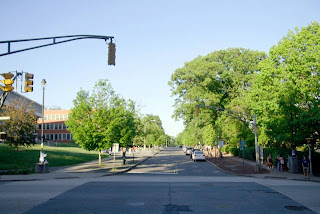My journey home began at 8:45 AM on Tuesday, August 23rd, when Charles, the driver hired to take us to Nairobi, cut short the long, leisurely goodbyes I had planned by arriving at Mpala, of all things, early—an occurrence which I didn’t know was in fact possible. I thought I had mastered the intricacies of Kenya time (everything is always late, always), but it seems that it is a dimension that I am destined never to fully understand.
Having left Kathleen at Mpala to meet her parents (who had flown in to spend an extra week touring around Kenya with her), Alice and I settled in for the five-hour ride to our hotel in Nairobi, along with Charles the driver, Meg and Jen (two more Princeton students) and Kathryn (a PhD student from Yale, but we liked her a lot anyways), the three of whom were all also leaving Kenya, and Kimani, a Kenyan researcher who wasn’t leaving the country, but hopped in at the last minute for the ride to Nairobi (I may not be totally up to speed on Kenya time, but I do at least know this about Kenya transportation—no trip anywhere is complete without picking up at least one extra guy along the way). The trip was mostly uneventful, though if the traffic through Nairobi had been any slower, I would have been seriously tempted to buy one of the freaking adorable baby bunnies a guy was hawking to passing cars.
After spending the night in Nairobi, we endured an eight-hour flight to London crewed by flight attendants who enjoyed nothing more than zooming up and down the aisles, ripping the blankets off of sleeping passengers to check for seatbelt-fastening compliance, every time the “Fasten Seatbelt” light turned on. The captain thoughtfully indulged this hobby by toggling the seatbelt light at short, regular intervals that bore no correlation whatsoever to the exterior turbulence levels.
As we tried to go through connecting security in Heathrow, Alice discovered that the Amarula Cream Liqueur that she had purchased at a duty-free shop in Nairobi, though contained in a sealed bottle in a sealed bag, would not be allowed through (because we had originated in Kenya, a country on their watch list. Had we brought the exact same item from Croatia, we would have been good). So Alice and I ended up killing the four-hour layover before our flight to Newark by exiting through immigration,
 |
| Exiting the airport resulted in possibly the shortest visit to London ever taken... |
 |
| ...though if this picture is any indication, we loved it. |
using a bunch of bubble wrap and sticky baggage tags to package the Amarula, and proceeding from check-in desk to check-in desk until we found an agent willing to check the bottle.
 |
| After all of that, we were about ready to drink the bottle ourselves. |
If anything else interesting happened over the course of the next seven-hour flight to Newark, seven-hour overnight layover in Newark, and six-hour flight to San Francisco, I was too deliriously exhausted to notice. Suffice it to say that eventually, I made it back.
Since I’ve been reflecting on all of my experiences in Kenya here in this blog over the course of the summer, I don’t feel like I need to write a big significant reflection here to wrap it all up. Actually, I doubt I’d want to do that even if this blog didn’t exist. One of the reasons I was so excited about this internship was that it presented a way for me to experience a very different country and culture while also working in a capacity that fit with the rest of my academic and future life goals. In other words, I didn’t want to just check the “visit a third-world country” box—I wanted whatever I did over the summer to have continuations into my post-summer life.
And it seems like this internship will. I might have left Africa, but I’ll reconnect with many of the people I met there back at Princeton (in fact, it turns out that one person will be my next-door neighbor!). I’ll also continue to be involved in the future of The Bucket Experiment at Mpala via phone and email, and I’ll report on the research I did at a PEI symposium for Princeton on September 30th (if you’re on campus, come by!).
If you liked this blog, you'll love my symposium presentation.
So while I understand the reasons for pausing to digest, I don’t want to write a reflection that will bring closure to an experience that I don’t plan on closing. I do want to recognize a handful of people, though, for their contributions to my summer:
Keir, John, Ekomwa, and Molly: the rest of the Mpala arm of Caylor Ecohydrology. Great bosses, great lab dynamic.
Chrissy, Bianca, Alex, and Meg: fellow Princeton undergrads, looking forward to a reunion in 10blank Little this fall!
Matt, Bob, Oscar, Grace, Kathryn, Enock, David, Irene, Laura, E.B., Alison, Katie, Zack, Mal, Val, Amy, Alicia, Caitlin, Mike (x2), Arnold, Janet, Adam and more: other Mpala researchers. Thanks for great sundowners and good luck to those of you sticking out the year.
Lawrence, Julius, Eunice, and the rest of the staff: if I could have a Kenyan godfamily, you would be it.
Alice and Kathleen: the other two members of “Kelly’s Angels.” I have never spent so much of one stretch of time with any other group of people, fencing teammates, roommates, and family members included. There are few people who I think I could have done it with and ended the summer really, really, liking and appreciating rather than loathing. I think our “Fill-My-Cup Bananagrams” said a lot, but I’ll say it again: you guys are fantastic.
 |
| "Kelly's Angels" |
Also, thanks to Elizabeth for writing this blog with me, and everyone who followed it. We were up to 4,500 hits when I last checked, and my hope is that we’ll make it to the five thousand mark by the time all’s said and done. What do you all think—should we write a sequel next summer?
Finally, I posted my favorite photos from the summer on Facebook. If you're not a Facebook person, you can see them by following this link.
Kwa heri!
-Hannah










































